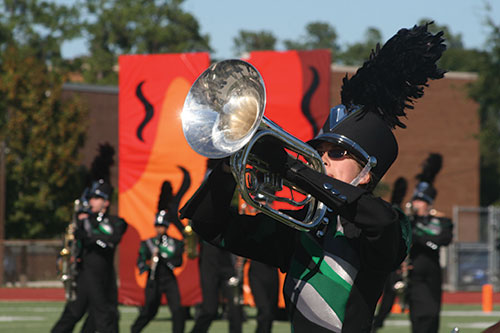
The key to a successful marching band camp is to set up a system. Ideally, there is a crew of student leaders in place well ahead of time. This creates an overlap between one team and the next, and students in leadership positions have time to reflect and prepare for the upcoming season. However, sometimes, this isn’t possible, especially for teachers hired late in the summer or for those who were unaware that they were expected to run a band camp. Here are tips for getting ready at the last minute.
Finding Help
If possible, reach out to the departing teacher to learn who some of the student leaders could be. If there is one, a middle school band director might have some suggestions as well. Barring either of these options, ask administrators or other teachers. If all else fails, do not be afraid to telephone students and ask for help. Say “I see you’re in band and a senior. Would you help be a leader of the band during band camp?”
Start with the seniors. It is their last year, and they are often the most invested in the program. Transitions between directors are difficult, but the students who still sign up for band after a teacher leaves are in the program for reasons other than devotion to a teacher and have skin in the game for making sure the transition goes well. Consider getting juniors on board, also. They can ease the transition into this year and the next.
Training Student Staff
Start band camp with just the student leaders and review technique with them. At the University of Iowa, we start with undergraduate staff rehearsals on the first day. Even a morning session with just the student staff will be a big help. This is an opportunity for practice teaching. Invite an experienced marcher to intentionally march incorrectly and give students a chance to identify and solve problems in a controlled environment.
Teach student staff how to teach. An influential article in my teaching was Verbal Instruction in Instrumental Rehearsals: A Comparison of Three Career Levels and Preservice Teachers by Thomas W. Goolsby (Journal of Research in Music Education April 1997). Inexperienced teachers – such as a student section leader – might say “let’s do that again,” but without explaining why it needs repetition or how to solve the problem. Even if student leaders do not know how to fix a problem on their own, they should still share what they hear with the others; perhaps the section can solve it together.
Another common mistake is to identify a problem without giving the group an opportunity to play through the passage again. If section leaders hear a problem in their section’s playing, they should run the passage again, and give additional feedback afterward: praise if the problem was solved or encouragement and another repetition.
Emphasize that students’ jobs are to teach and to help, not to be the boss. I am a fan of legendary UCLA basketball coach John Wooden and his rule that students were not allowed to criticize other students. He would say criticism was his job as the one in charge, but if students wanted to help each other, that was a different story. In the Hawkeye Marching Band the hierarchy is squad leaders at the bottom, then section leaders, drum major, graduate staff, and finally director Kevin Kastens. Knowing that there is someone to go to for assistance makes solving problems simpler. Squad and section leaders have important jobs, but they are not in charge of the program, and having everyone know that makes things easier on the student staff.
Delegating Responsibilities
Delegation is one of the signs of an effective teacher – they can distribute the load instead of carrying it all themselves. The former Iowa director of bands Myron Welch once told me that the people who don’t learn to delegate don’t last.
Start music rehearsals in like instrument groups. This gives students a chance to hear each other and build community. Students can easily lead warmups and tuning. There are many tuning apps available for download and therefore no reason why a section leader with a smart phone or tablet cannot have one available.
When working on marching basics, occasionally pull section leaders out to guide people and help with technique. People holding back their section or the overall progress of the band can be pulled out of the block to work with a leader one on one. Diligence during camp with fundamentals can be an ounce of prevention saving you a pound of cure later. If your student staff members have strong mastery of marching techniques, they can teach these as well, but even if some of your volunteers that first year are not completely solid, they can still be pulled out to observe other students. They will be more solid than new band members. As an example, when marking time, some people tend to creep back and forth. They may be unaware of this, but any observer can point it out.
During drills (such as a box drill), have student leaders call out commands, so no one forgets which direction to go. Other band members should echo these commands after they hear them. This includes commands like mark time and horns up.
Section leaders can also be a demonstration group. Have them model various techniques to the rest of the band. This is an ideal use for section leaders. When they are pulled out of rank to observe, that is one less repetition they get. Occasionally calling them out to demonstrate to the rest of the band gives them the practice they miss at other times in rehearsal. A good demonstration exercise with everyone on the field is to run a box drill and have section leaders play a concert Bb scale while other band members practice calling out what is coming up. Then switch roles, so section leaders are providing the reminders while everyone else is playing and marching. The end goal of this exercise is no verbal commands at all.
Assigning Permanent Roles
A formal leadership structure is helpful, but, in a last-minute camp, you could delay final leadership decisions until the end of band camp. This gives you time to get to know the volunteers and evaluate who would be the best permanent leaders.
Selflessness is the number one trait I look for in student leaders. These students are not there to be taken advantage of, but those who are generous with their time and knowledge will be the most beneficial to the program. They should also be good teachers, able to demonstrate technique. Although you don’t want a section leader who struggles to play or march well, sometimes the best performer is not the best teacher. The best performer may not be able to relate to struggling students well. Leadership is not a popularity contest, but student leaders should also be likeable and approachable, so struggling students are unafraid to ask for help.
Quick Tips for Success
Never assume students know something. The Green Bay Packers suffered a last-minute loss in the 1960 NFL Championship game. When camp started the next July, the first thing Coach Vince Lombardi did was hold up a football and say, “This is a football.” He started with the basics, and the Packers became the best at them. Likewise, Denis Wick wrote about taking summers away from his instrument. Then when he picked up his trombone again in August he would meticulously focus on every aspect of playing and get the smallest details perfect.
Give students an overview of the show. Directors spend hours writing – or at least studying – drill, but students see things from their spot on the field, one move at a time. If you design drill on computer, let students watch how the show progresses. Students may benefit from viewing drill on an app on their phone. Seeing the bigger picture helps them know what the group is working toward.
Insist that students use the correct terminology. Teach it, and then expect students to use it. Some students will be too shy or intimidated to ask about unfamiliar terms, and marching bands are usually large enough that it is possible to spend the entire season hiding. Make sure everyone knows what you are talking about when you use phrases like “cover down.”
Split the yard line. Many bands have their rehearsal block organized so all students are on a yard line. For variety, condense the form so some students are on a yard line and some are halfway between them, and work on daily marching drills this way. Then have everyone move up four steps so the other half of the band has to work splitting the yard line.
Practice multiple step sizes. We work eight-to-five steps often, but occasionally work twelve-to-five or sixteen-to-five as well. This gives students practice on adjusting step sizes. A drill I like is mark time 8, forward march 8 (eight-to-five), forward march 16 (sixteen-to-five). Combine this with splitting the yard line. Students may be tempted to fudge step sizes if they overestimate the first few steps. Watch for this, and give students an opportunity to do it again correctly. Otherwise, students only learn how to come close to the target and make up the difference at the end of the move.
Have students freeze. Explain, “When we start this next exercise, I’m going to say ‘one-and-two,’ and everyone should freeze in place on beat two.” Staying frozen in place can be taxing, so avoid it for longer than it takes for student leaders to check everyone’s position and make corrections as needed. To break things down further, freeze the band on the and of the beat. Consider having students take pictures or video of each other so people can evaluate their marching technique. Also record students demonstrating good technique, so you can send video for students to watch before rehearsal.
Use a drone with video capability for a new perspective on how the band looks. Check with your administration, but drone use is becoming much more common as a diagnostic tool in marching band rehearsals.
Bring in guests to work directly with your band or observe and offer suggestions to you. Timing and availability during band camp season can be tricky, but if not a neighboring director, then perhaps college directors or even college students still on summer break. People who have judged your group in the past are another option. A new perspective is always helpful, and clinicians are useful for emphasizing concepts from the podium. Sometimes hearing your thoughts from someone else’s mouth is what makes a concept stick.
Finally, end camp on a high note by showing off student progress at a parents’ night. March the show (or part of it) and perform all the music. Parents will appreciate the time and energy invested, while students will get the thrill of performance and a rewarding conclusion to camp. This is an important benchmark from which you can measure growth throughout the season and generate ideas on how to approach the next rehearsal.






